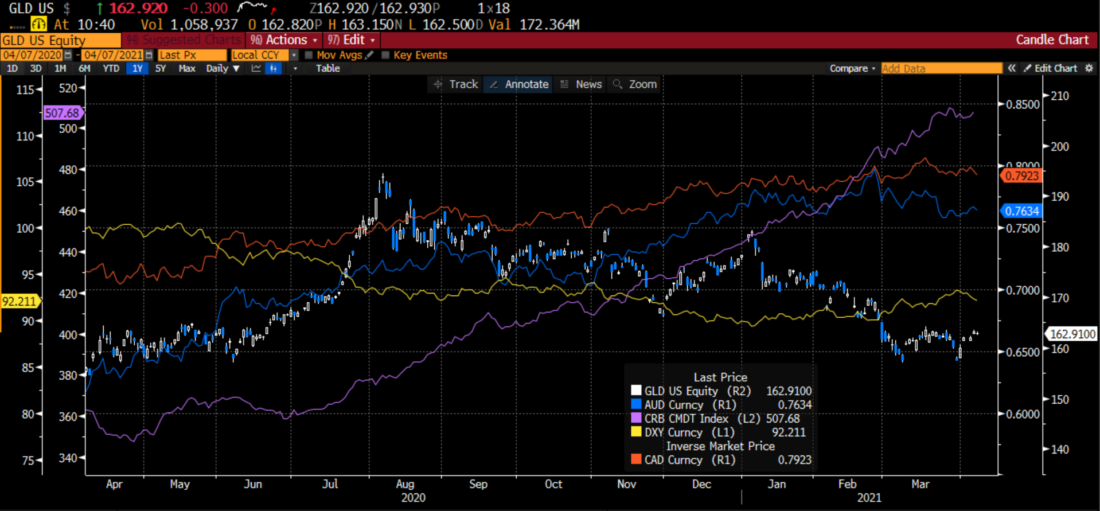We have previously written about how gold has been failing as a hedge against inflationary worries for the past few months, and has instead functioned more as an anti-USD during that time. After a recent appearance on Australian TV and ahead of a webinar in Canada, I have been digging deeper into the relationship of those commodity dependent currencies to gold and inflation as well. While the Australian and Canadian dollars have been showing relative strength versus their US counterpart, even they have failed to keep pace with skyrocketing commodities prices.
The chart below is complex, but it illustrates that while there are similarities among the price movements in gold, the US dollar, the CRB Index and the Australian and Canadian dollars, the relationships are far from iron-clad.
GLD (candles), Australian Dollar (blue), Canadian Dollar (inverted, red), DXY (yellow), CRB (purple)

Source: Bloomberg
First, we can see the largely inverse price action between the price of SPDR Gold Shares (GLD) and the US Dollar Index (DXY). As the candles representing GLD rise, the yellow line representing DXY falls, and vice versa. That is to be expected, to an extent. If the dollar strengthens, fewer are required to buy a fixed amount of gold. That is the same for any commodity – at least in theory, and as long as supply and demand for that commodity remains largely stable. Yet we see the Commodities Research Bureau Spot All Commodities Index (CRB) climbing at a much faster pace than DXY. It should surprise no one that the perception of a rapidly improving global economy would increase demand for the commodities that are required to build that economy and satisfy consumer demand. Copper, lumber and oil are just three examples of commodities that have seen significant price bounces off of pandemic low levels. If we’re building houses or traveling more, we need more of those commodities. Now consider whether more demand for gold has been created. I will assert that any incremental demand for gold is quite minimal compared to the incremental demand for a wide range of commodities. Hence gold’s failure to act as a meaningful inflation hedge.
Unfortunately, when viewed in a different light, this chart reveals a concern about the purchasing power of the US dollar. If commodity prices are zooming higher against a relatively stable dollar, it implies that more dollars are required to purchase a similar amount of commodities. That, dear readers, is the very definition of inflation. As noted above, I think that some, if not most, of the recent commodity price inflation is demand driven. A succession of fiscal stimuli and an expanding Federal Reserve balance sheet play huge roles in spurring that demand. That, as a software developer would say, is a feature, not a bug. In other words, these are logical and intended effects of governmental and monetary policies.
We may learn more about whether the Fed is concerned about inflationary kindling when the FOMC minutes are released later today. So far, at least publicly, any concerns have been muted – if not dismissed outright. In the meantime, it is worth exploring the extent to which currencies of commodity producing countries are acting as an inflationary hedge in their own right. That brings us back to the Australian (AUD) and Canadian (CAD) dollars. Both come from countries that are physically large, with low population density and blessed with enormous natural resources. As a result, international investors have often used those currencies as proxies for commodity prices. We can see from the blue and red lines in the chart above that the AUD and CAD have been steadily rising over the past few months. For most of that period, they have generally kept up well with the rise in CRB. The problem is that over the past 6 weeks or so, CRB took a sharp leg higher while AUD and CAD did not. They failed to hedge the most recent leg of the rally in commodities prices as they had done before.
I believe that some of the failure for CAD and AUD to keep pace to with CRB is the effect of the most recent $1.9 trillion US stimulus package. The US stimulus can certainly benefit the economies of key trading counterparts, but the effect is of course likely to benefit the US economy most. Hence, the relative underperformance of those two currencies vis-à-vis the commodity price spike spurred the stimulus package.
Bottom line, if you’re looking for a hedge against commodity price inflation, gold is still not it. The currencies of key commodity producing economies have been somewhat of a haven throughout most of the recent commodity price rally, but even they have been of limited benefit over recent weeks. It appears that the best way to protect oneself from commodity price rises is likely to be more direct investments in key commodities or in equities that are direct beneficiaries of those price increases.
Disclosure: Interactive Brokers
The analysis in this material is provided for information only and is not and should not be construed as an offer to sell or the solicitation of an offer to buy any security. To the extent that this material discusses general market activity, industry or sector trends or other broad-based economic or political conditions, it should not be construed as research or investment advice. To the extent that it includes references to specific securities, commodities, currencies, or other instruments, those references do not constitute a recommendation by IBKR to buy, sell or hold such investments. This material does not and is not intended to take into account the particular financial conditions, investment objectives or requirements of individual customers. Before acting on this material, you should consider whether it is suitable for your particular circumstances and, as necessary, seek professional advice.
The views and opinions expressed herein are those of the author and do not necessarily reflect the views of Interactive Brokers, its affiliates, or its employees.
Disclosure: Forex
There is a substantial risk of loss in foreign exchange trading. The settlement date of foreign exchange trades can vary due to time zone differences and bank holidays. When trading across foreign exchange markets, this may necessitate borrowing funds to settle foreign exchange trades. The interest rate on borrowed funds must be considered when computing the cost of trades across multiple markets.
Disclosure: Futures Trading
Futures are not suitable for all investors. The amount you may lose may be greater than your initial investment. Before trading futures, please read the CFTC Risk Disclosure. A copy and additional information are available at ibkr.com.































